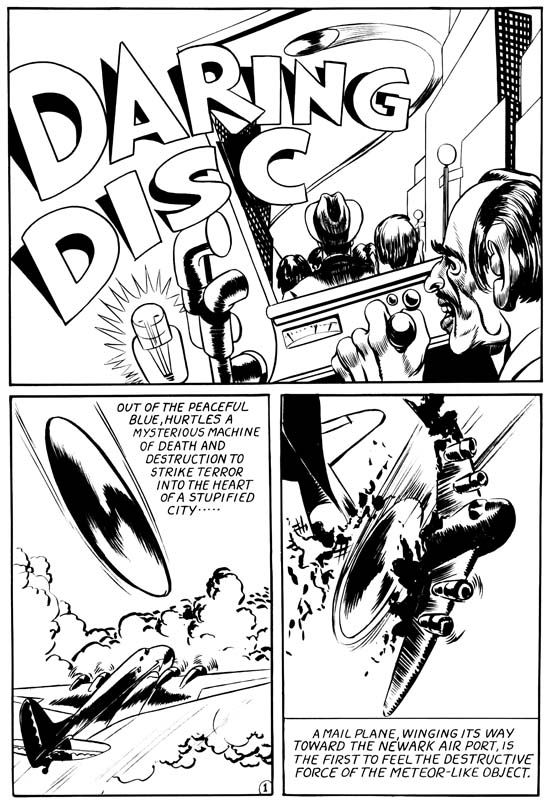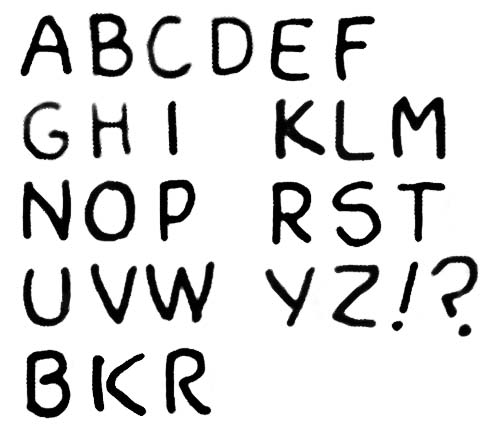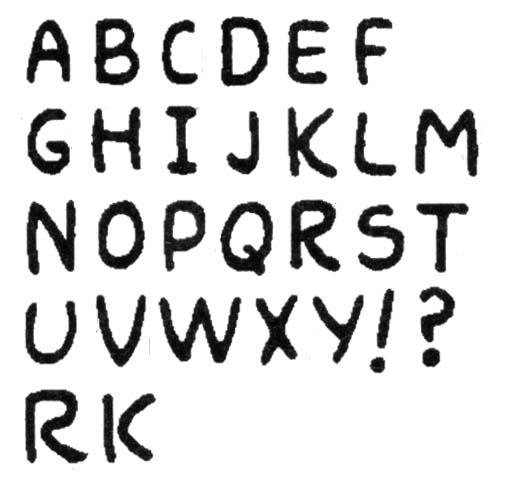
Daring Disk, pencils by Jack Kirby
Occasionally a title would be cancelled leaving Simon and Kirby with some unused art. Even then Joe and Jack would often rework the art so as not to waste the effort that went into it. In one case the work for the Fighting American #8 that was cancelled by Prize Comics in 1955 ended up being used in the comic published by Harvey in 1966. Because of the recycling there is only a limited amount of Simon and Kirby work that avoided publication until the more recent rise of reprint books. For most of the art that escaped being used there is ample evidence for what it was originally intended. All this makes the story Daring Disc is so unusual. It is a very early Simon and Kirby art that originally never got published and for which there is no firm evidence as to what title it was meant for and therefore exactly when it was created.
The art style is such that we can be pretty certain it was done early in the Simon and Kirby collaboration. But I would like to examine the evidence that the work provides that might narrow down when it was created.
I do not believe the inking helps much. It does not look to me like the inking that Kirby did on his own pencils in stories such as the Solar Legion that Jack did for Crash Comics (#1 to 3, May – July 1940). But Kirby was variable in the inking of his very early work (see A Brief Pause, Another Brief Pause and It Ain’t Soup ) so it hard to be sure whether this is his inking or not. It might have been inked by Joe Simon or someone else but that would hardly help in narrowing the time period.

“Daring Disk”, letters by an unidentified letterer
I believe better information can be obtained by the lettering. This is not a very professional letterer (many were not during those early days of comic books). His lettering can easily be distinguished from that by Jack Kirby, Joe Simon or Howard Ferguson, the most frequently used letterers for Simon and Kirby work from the early 40’s (see Chapter 5 of In the Beginning for examples of all three). This trio did most of the most of the lettering during the initial Simon and Kirby collaboration. Joe and Jack most frequently in the earliest period and Howard predominantly later. However other letterers were common during the period from July to September 1940. Sometimes another letterer was used later for example in the Vision story from Marvel Mystery Comics #17 but by then Kirby’s pencils were done in a style that does not match that found in Daring Disk and therefore can be discounted. So based on the use of an non-typical letterer and the art style July to September 1940 seems to be the most likely date* for Daring Disk.

Marvel Mystery #10 (August 1940) “The Human Torch”, letters by an unidentified letterer (from Marvel Masterworks)
While I cannot identify the letterer of Daring Disc his work looks very much like that found in the Human Torch story from Marvel Mystery #10 (August 1940). The lettering examples I provide for both the Daring Disk and MM #10 were derived from the speech balloons while the same type of lettering is found in the captions only it is slanted in both pieces. Further drop capitals** were not used in either work. Simon was the Timely editor so it is likely that he would have known and could supply work to the letterer from MM #10. MM #10 August cover date matches the July to September dates that I suggested above.
These is one other piece of evidence to consider the title of the piece. Why Daring Disc? Horrible Disc, Terrible Disc or something of that nature would seem more appropriate. But perhaps it was called Daring because it was meant for Daring Comics. A similar use of Daring in the title was used for Captain Daring by Jack Kirby (Daring Mysteries #6, September 1940). Simon’s work appeared in the early issues of Daring Mystery but Kirby’s first appeared in Daring Mystery #6 (September 1940) and later in DM #7 (April 1941) and #8 (January 1942). But again Kirby’s art had developed by DM #7 into a style that I do not think matches Daring Disk.
Granted this is not the greatest evidence but it seems the best available. so based largely on the use of a letterer other than Simon, Kirby or Ferguson I would suggest Daring Disk would cover date from July to September 1940. The particular letterer used and the title are even less firm evidence but they agree with those dates as well.
footnotes:
* These are cover dates, calendar dates would put the creation of the art 5 or 6 months early; January to April 1940.
** Drop capitals is the term I use for enlarged and sometimes shadowed first letter of the captions.

